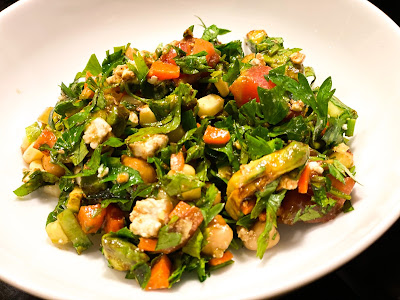Transform ordinary balsamic vinegar into thicker, slightly sweet reduced balsamic to make a best-ever salad dressing.
Reduction is a simple and effective way to increase flavor by reducing the water content of a liquid using heat or evaporation.
Reduction transforms inexpensive balsamic vinegar into an extraordinary sauce. At a restaurant supply store like Smart and Final, 5 liters of Italian balsamic vinegar sells for under $20.00. 5 liters will make 40 ounces of reduced balsamic, enough for a hundred servings.
Reduced Balsamic Vinegar
Like vinegar in general, reduced balsamic does not need refrigeration and will last indefinitely.
To make an oil and vinegar salad dressing, combine 1 teaspoon of reduced balsamic with 1/2 cup extra virgin olive oil. Mix well and drizzle over tossed lettuce, tomatoes and burrata or chopped Italian parsley and feta.
Time to prepare: 10-15 minutes or 10-15 hours depending on the amount of vinegar being reduced
Ingredients:
1/4 cup Italian balsamic vinegar to make a single serving or 1 large 5 liter bottle to make 40 ounces
Directions:
For an individual serving, pour 1/4 cup of vinegar into a small saucepan and heat over a slow flame. That will take 10-15 minutes and make about a tablespoon. Let cool and mix with olive oil to use as a salad dressing to serve 4.
For an individual serving, pour 1/4 cup of vinegar into a small saucepan and heat over a slow flame. That will take 10-15 minutes and make about a tablespoon. Let cool and mix with olive oil to use as a salad dressing to serve 4.
To make a larger quantity, pour the 5 liters of balsamic vinegar into a large pot. Open the kitchen windows and heat the vinegar. Be careful to keep the flame on low. A gentle simmer is good.
As the volume of vinegar reduces, adjust the flame to avoid boiling, which creates an unpleasant flavor.
5 liters of vinegar will take 8-10 hours to reduce to 20% of the original volume. Use a small spoon to taste the vinegar. When thickened, the balsamic has a slightly sweet flavor. Roughly speaking, 5 liters will make 40 ounces of reduced balsamic.
5 liters of vinegar will take 8-10 hours to reduce to 20% of the original volume. Use a small spoon to taste the vinegar. When thickened, the balsamic has a slightly sweet flavor. Roughly speaking, 5 liters will make 40 ounces of reduced balsamic.
If the balsamic reduces too much and is too syrupy, add a cup of water, stir well and heat. Add more water until you have the consistency you enjoy.
Use a funnel to fill plastic squeeze bottles. I prefer a 4 ounce bottle for easy handling. 5 liters of balsamic vinegar will make nine to ten 4 ounce bottles.
As the balsamic reduces, sometimes, a film or solids might develop. If so, wet a piece of cheese cloth and put it inside a funnel placed into a squeeze bottle. Pour the reduced balsamic through the cheese cloth and fill the squeeze bottles. When all the bottles are filled, squeeze the cheese cloth so you capture all of the balsamic. Rinse clean and dry the cheese cloth.





























